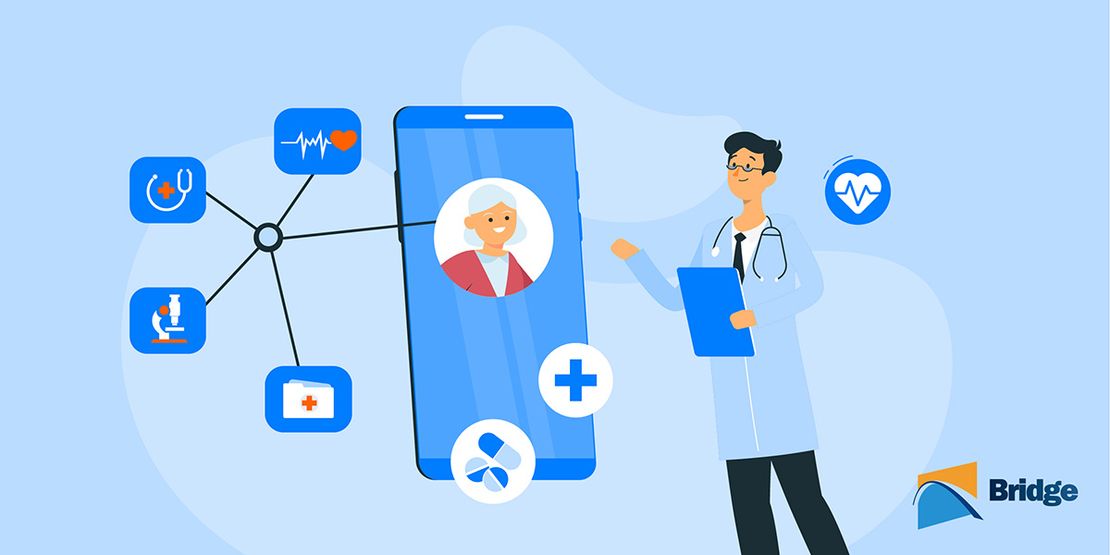Why Cancer Patients Need a Cancer mHealth Application
- The Bridge Team
- June 14, 2022

Cancer is a complex disease that is the second leading cause of death in the United States. Although mortality rates continue to decline due to preventative efforts and better care, cancer diagnoses overall are predicted to increase[¹] in North America over the next few years. Healthcare providers that treat cancer can better serve their current patients and prepare for the future by investing in solutions that improve patient outcomes.
International Agency for Research on Cancer (2020.). Cancer Tomorrow. [online] Available at: https://gco.iarc.fr
The Current State of Cancer Patient Care
Cancer patients require greater access to ongoing care than any other type of patient: multiple follow-up visits, complex care plans, prescription management, frequent communication with providers and staff, and symptom monitoring are common. This level of ongoing care requires patients to take a much more active role in their health. As a result, access to digital tools that help cancer patients manage their treatment are becoming essential.
A recent study found that individuals with a recent cancer diagnosis were more likely [²] to view their medical health records than those who have never had cancer and 75% of cancer patients own a smartphone or tablet that they can use to access online records.
Furthermore, patients who had access to their medical records report feeling reassured, reduced anxiety, improved consultations, better doctor-patient relationships, increased adherence to medication, and improved outcomes [3]. Healthcare organizations need to provide cancer patients and those in recovery with a secure and reliable digital platform, such as an oncology mobile health application that will allow them to access their healthcare information.
Cancer Patients Need a Rich Cancer mHealth Application
Secure, convenient access to online medical records enables cancer patients[³] to manage complex and ongoing health information needs. The cancer mHealth application features that cancer patients need access to include prescription refill requests, filling out and submitting online forms, updating medical records, secure messaging with providers, and viewing and transmitting medical records.
Benefits of a Patient Portal Solution
A patient portal can be an affordable mHealth app solution that integrates data from various source systems, including Electronic Health Record (EHR), Revenue Cycle Management (RCM), or Practice Management (PM) systems, and presents the patient’s data in an easy-to-use web or mobile application that they can access anytime from any smart device. This integration allows cancer patients to access their medical records without experiencing gaps in their care.
Access to a patient portal through an oncology mHealth app has many benefits. Some healthcare benefits include improved communication between physician and patient, the self-management of overall wellness, and improved patient health behaviors.
Bridge’s mHealth App Platform
Bridge offers healthcare organizations a cancer Mobile Health application that can enhance the provider’s workflow without exhausting the company budget. Healthcare organizations can choose a suite of pre-built and custom features to provide patients with a “one-stop-shop” app. The oncology mHealth application includes:
- iOS and Android compatibility
- A singular app platform for the entire healthcare organization
- Private-label branding
- Ability to select from a suite of pre-built features or add custom features
- Support for multiple, concurrent interfaces
- Advanced patient authentication and security
All patients benefit from better access to their healthcare professionals and records – and cancer patients are especially likely to require easy, streamlined ways to manage their healthcare whenever possible. Healthcare organizations that invest in best-practice tools, such as the cancer mHealth app, will be better equipped to serve current and future cancer patients.
- Siegel, R.L., Miller, K.D., Fuchs, H.E. and Jemal, A. (2021).Cancer Statistics, 2021. [online] CA: A Cancer Journal for Clinicians, Available at: https://acsjournals onlinelibrary.wiley.com/doi/10.3322/caac.21654
- Johnson C, Krakow M, Patel V. (January 2020). Trends in Individuals’ Access and Use of Online Medical Records and Technology for Health Needs: 2017-2018. ONC Data Brief, no.50. Office of the National Coordinator for Health Information Technology: Washington DC. [online] Available at: https://www.healthit.gov/sites/default/files/page/2020-01/2018HINTSCancerDB.pdf
- Tapuria, A., Porat, T., Kalra, D., Dsouza, G., Xiaohui, S., & Curcin, V. (2021). Impact of patient access to their electronic health record: Systematic review. Informatics for Health and Social Care, 46(2), 194–206. Available at https://doi.org/10.1080/17538157.2021.1879810

